Introduction
The definition of a meat analog or meat alternative refers to the replacement of the main ingredient with a non-meat product, which can also be called a meat alternative, meat substitute, fake or mock meat, and imitation meat (Ismail et al., 2020). These products are principally made of pulses (mainly soy), cereals, or fungus protein, although the utilization of insects and seaweed as new protein sources has recently been considered (Megido et al., 2016). In fact, products made from plants, insects, and mycoprotein-derived substances are sold in the product market. These products are sold under the name of plant-based food, insect food, and mycoprotein food, which do not contain the word meat (CFR, 2023). While plant-based meat analogs are considered an attractive option to consumers, there are many limitations in traditional processing techniques used in the marking of meat analogs, which can lead to a loss of product taste and sensory quality, thereby reducing consumer acceptability (Grasso et al., 2021). Despite the increase in popularity and presence of plant-based meat analogs, there is limited evidence regarding the nutritional healthiness of these products (Melville et al., 2023). Indeed, plant-based meat analog technologies (meat shape, color, taste, etc.) have been developed and the market has increased; however, in recent years, the sales of meat analog have slowed and the industry stock prices have also begun to decline. Although meat analogs are attracting attention as an alternative to the consumption of meat, the main reason for the reduction in the growth of the related market is that the taste and quality of the product have not yet reached that of traditional meat products. In order for all meat analogs, including cultured meat, which has not yet entered the market, to grow in the current market, it is essential that technologies are developed to enhance their taste and quality. Therefore, this study was conducted to predict the future of the meat analog market by investigating the current technological developments and industrializations related to meat analogs.
Summary of Current Technologies and Industrialization in Meat Analogs Made from Plant-Based Materials
Plant-based materials are the most accessible materials for meat analogs, and have been consumed as food by extracting and processing plant proteins since the ancient times; tofu made from coagulated soybean protein, tempeh containing abundant lactic acid bacteria by fermenting soybeans, seitan made using wheat gluten from which starch has been removed, and falafel made using chickpeas (Cooper, 2015; He et al., 2020; Ismail and Kucukoner, 2017; Maningat et al., 2022). The plant-based food consumption includes not only processed-soy protein but also simple intake of high-protein plants such as spelt wheat, teff, quinoa, amaranth, oat, and hemp seeds (Balakrishnan and Schneider, 2022; Cooper, 2015; Crescente et al., 2018; Kahlon and Chiu, 2015; Mel and Malalgoda, 2022; Vega‐Gálvez et al., 2010). Table 1 shows meat analogs to mimic meat by processing plant-based protein. Most of the papers in the current literature described the below-used ingredients that were derived from grains or soybeans as raw materials. Diaz et al. (2022) processed fibrous meat analogs (FMAs) by extruding commercial oat fiber concentrate (OFC) and pea protein isolate (PPI) using twin-screw laboratory extruder. FMAs were made by adjusting the contents of OFC and PPI (Table 1). They supplemented the reduction in FMA texture due to the oat fiber by controlling the manufacturing temperature and confirmed that this characteristic was related to beta-glucan extract (Diaz et al., 2022). Similarly, a study using cereals (rice) and beans (soybeans) developed meat analogs with unique textures called textured rice protein (TRP; Lee et al., 2022). They prepared 4 types of TRP (TRP 25, 50, 75, 100) by adjusting the ratio of prepared rice protein isolate (RPI) and soy protein isolate (SPI; Table 1). A meat analog extruded dough with the ingredients above-mentioned along with cornstarch and wheat gluten (Table 1). By analyzing the extruded dough, they confirmed two things: 1) Protein molecules bind to water molecules, and water molecules are required for binding between protein molecules. Therefore, since the water affinity of RPI is lower than that of SPI, more elastic dough was formed in the treatment group with high SPI content. 2) The higher mass flow rate of the dough, the shorter the time it stays in the extruder, and reducing the degree of protein denaturation. SPI has a good affinity for water, so the binding force of the dough is very high, so the mass flow rate of the SPI dough is lower than that of the RPI. Mixing of RPI is required to lower the high mass flow rates (Lee et al., 2022). The addition of RPI reduced the porosity or water absorption ability of the final TRP, but this is a way to supplement amino acid components that may be insufficient with RPI and SPI alone (Lee et al., 2022). Therefore, a new possibility of implementing rice protein was presented to the meat analog raw material market, which subsequently concentrated on soybean protein. Another study attempted to replace fat as well as meat in meat analogs (Revilla et al., 2022). They made frankfurters by using olive oil to replace backfat and pea protein to replace meat. As pea protein was added, the color of the product became pale, but it was confirmed that up to 50% of meat can be replaced with pea protein. Nevertheless, this recipe using olive oil produced sausages with better emulsion stability and healthy fat compositions than using pork backfat (Revilla et al., 2022). Jung et al. (2022) used a special method called ‘ohmic’ to produce meat analogs. This method rapidly heated the meat analog by applying an electric field (AC voltage of 60 Hz), which enhanced the color condition of the product. During the ohmic process, changes in temperature, voltage, and current can be monitored by using a 34970A Data Acquisition system (Table 1). Chen et al. (2022) also used extrusion technology to prepare meat analogs. They combined amylose and amylopectin together for texture and bonding strength and suggested that the “sublayer transformation” that occurred during the extrusion was a key factor in producing a meat-like texture. In addition, it fixed the characteristics of the product by controlling the cooling die temperature after extrusion similar to Diaz et al. (2022; Table 1). Moreover, Keerthana Priya et al. (2022) specifically studied plant-based meat analogs (sausages) using jackfruit and banana florets (Table 1). They supplemented the lack of protein with some pea protein, which ultimately led to the development of a low-fat, fiber-rich vegan sausage. In addition, this vegan sausage contained the texture and physicochemical properties of a sausage that was sufficient to replace meat. This application involved the meaningful development of biomass, which can be used as a raw material in meat analogs alongside commonly used grains, legumes, and wheat flour. Some studies have focused on the fibrous and layered structure of meat analog products–for example, a study using pea and wheat proteins confirmed changes in the properties of meat analogs, which contained variations in the ratio of these two ingredients (Table 1; Yuliarti et al., 2021). Pea protein increased the firmness, chewiness, and viscoelasticity of the meat analogs, whereas wheat protein demonstrated the opposite trend. They confirmed that the meat analog structure was affected by the cross-linking rate between protein molecules and revealed that the most desirable meat analog formulation was obtained when the pea and wheat proteins were mixed at a ratio of 13:4 (Yuliarti et al., 2021). Kim et al. (2021a) and Kim et al. (2021b) conducted continuous research on manufacturing meat analogs with pulse proteins. Soy concentrate and soy isolate (soy-based protein) were mixed and used as control, and pulse proteins (PLP: pea isolate, pea protein, lentil protein, and fava bean protein) were combined as treatments (Table 1), and these are called high-moisture meat analogs (HMMA). According to this, soy-based HMMA formed the best fiber orientation, and treatment with PLP had less brightness, texture, color, and moisture content (Kim et al., 2021b). The use of a 2% brine solution has shown potential for being the most effective method in the preparation of HMMA (Kim et al., 2021b). In a follow-up study on the manufacturing of hamburger patties, the texture and sensory characteristics of the patties manufactured using general soy-based protein and patties using pulse protein were evaluated (Kim et al., 2021a). Patties containing pulse protein were more effective in reducing cooking yield and cooking time than control (soy-based protein) patties. Although the overall cohesiveness and texture preference, such as gumminess, was relatively low, it was evaluated as a sufficient substitute for general soy concentrate (Kim et al., 2021a). While legumes are predominantly considered a source of alternative proteins, peanuts have received relatively little attention (Zhang et al., 2020). Peanut protein powder was mixed with carrageenan, sodium alginate, and wheat starch and extruded to make a meat substitute. In this study, the meat protein structure and texture mimicry lacking in the peanut protein was improved through additives. It was found that the addition of carrageenan increased tensile resistance, sodium alginate increased fiber quality and elasticity, and adding wheat starch could improve the fibrous structure of the final product during extrusion (Zhang et al., 2020). Furthermore, Chiang et al. (2019) conducted a study to improve the quality of a soy protein concentrate meat analog by using wheat gluten. Wheat gluten contains gliadin and glutenin and plays an important role in maintaining the structure and binding (Chiang et al., 2019). The addition of 30% wheat gluten by weight effectively changed the fibrous structure of the meat analog. In the high-moisture extrusion process, disulfide bonds aided in the fibrous structure of the meat analogs, owing to the crucial role employed by the wheat gluten (Chiang et al., 2019). Prior to the study by Chiang et al. (2019), there were studies that used soybean protein and wheat gluten in the Couette cell technique (Krintiras et al., 2015). Here, they filled a Couette cell with a mixture of the aforementioned ingredients, along with water and salt, and analyzed the treated product. The Couette cell is a specialized product for dough behavior studies, although it has also been used to check the manufacturing conditions of meat analogs (Krintiras et al., 2015). Couette cell is based on the common concentric cylinder rheometer concept (Table 1). The manufactured product was used to confirm that the mixture could sufficiently structure the fibrous anisotropic and layered materials (Krintiras et al., 2015). Most of the previously mentioned studies used soybean protein as a replacement for meat protein, yet additional research to replace soybean protein is also underway (Keerthana Priya et al., 2022; Zhang et al., 2020).
| Main source of products | Ingredients or technologies | Main procedure and products | References |
|---|---|---|---|
| Fibrous meat analog (FMA) using oat fiber concentrate (OFC); pea protein isolate (PPI) | • FMAs were produced using a twin-screw laboratory extruder coupled with a long cooling die. • Various conditions can be selected to extrude FMAs (as shown below). • OFC levels: 25–75 of solids, temperature of long cooling die: 40°C–80°C, screw velocities: 300–500 rpm • Reverse osmosis water was the only liquid component supplied to the extruder (moisture content 60%), and the total feed rate was 85 g/min. • The FMAs were cut into pieces (20 cm long) at the exit, placed in polyethylene zip-lock bags, and stored at –20°C. • Contents of FMA: OFC 100, OFC:PPI 70:30, 50:50, 30:70, PPI 100% |
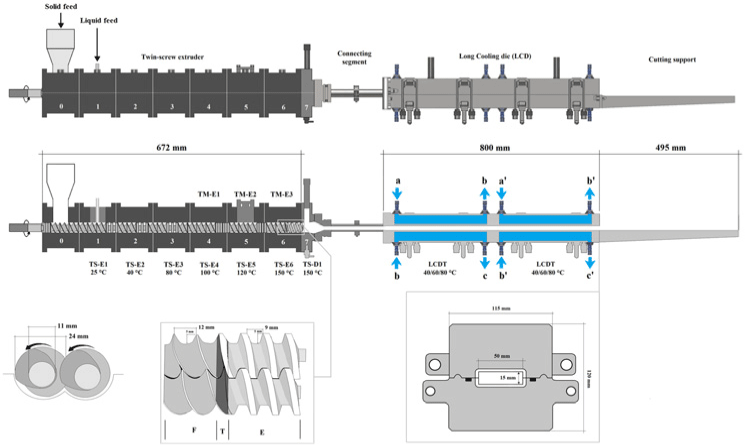 High-moisture extrusion using twin-screw extruder and long cooling die 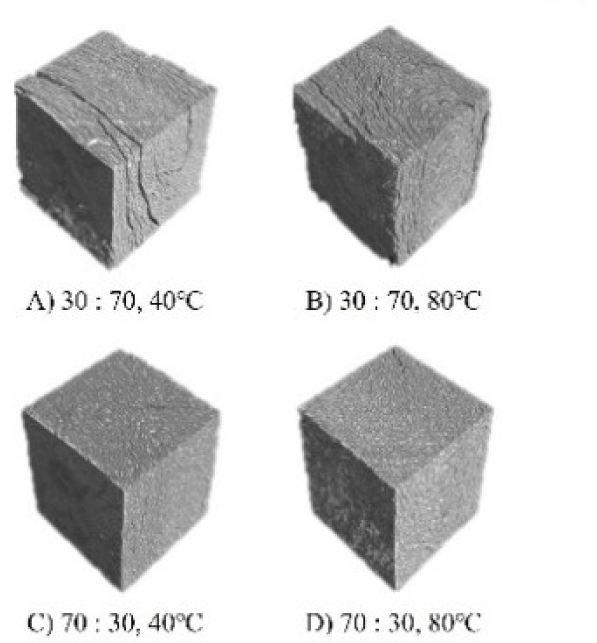 |
Adapted from Diaz et al. (2022) with CC-BY. |
| Low-moisture extruded meat using rice protein isolate (RPI); soy protein isolate (SPI) | • The blend compositions used to prepare the textured rice protein (TRP) samples are listed below: 1. TRP25: RPI: 14%, SPI: 44% 2. TRP50: RPI: 29%, SPI: 29% 3. TRP75: RPI: 44%, SPI: 14% 4. TRP100: RPI: 58%, SPI: 0% • The other amounts were fixed at corn starch: 29%, and wheat gluten: 13%. • Dough extruding by Parallel twin-screw extruder (HAAKE Process 11): two screws of 11 mm×440 mm (D×L). |
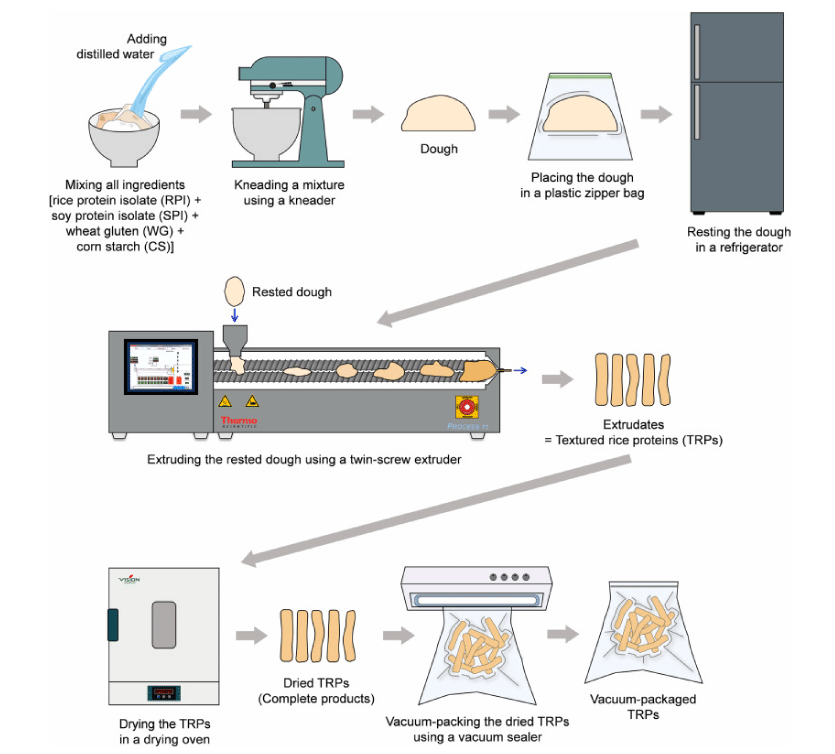 Low-moisture extrusion using twin-screw extruder 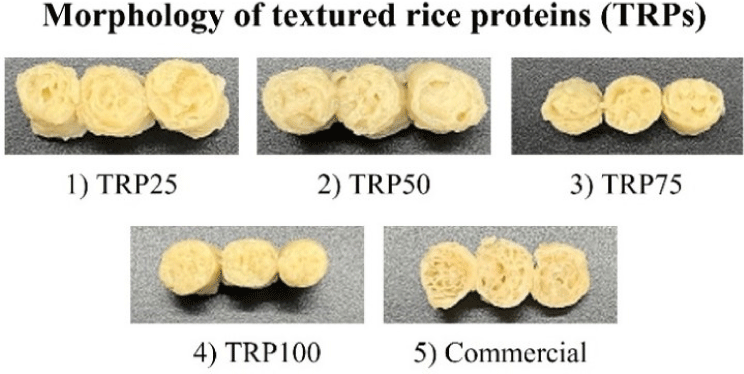 |
Adapted from Lee et al. (2022) with CC-BY. |
| Low-fat frankfurters using pea protein; olive oil | • Replacing lean pork (meat) with pea protein by 25%–100%. • Replacing pork backfat with 40% or 100% olive oil. • The dough was mixed with a cutter while adding seasoning including ice to soy protein or meat. After that, olive oil or backfat and the remaining ice were added to make the particles uniform. • The dough was filled in a cellulose casing and steam-cooked in an oven. |
Sausage-making procedure replacing meat and backfat | Revilla et al. (2022) |
| Fibrous meat analog using SPI | • SPI 25.9%, wheat gluten 13.0%, corn starch 1.9%, methyl cellulose 0.9%, red beet powder 1.3%, soybean oil 0.9%, salt 0.5%, and distilled water 55.6%. • Using a container with a thickness of 20 mm and a size of 111 mm×88 mm×60 mm as a mold, a square-shaped meat analog dough was molded during ohmic cooking, and an AC voltage of 60 Hz was applied across the sample. |
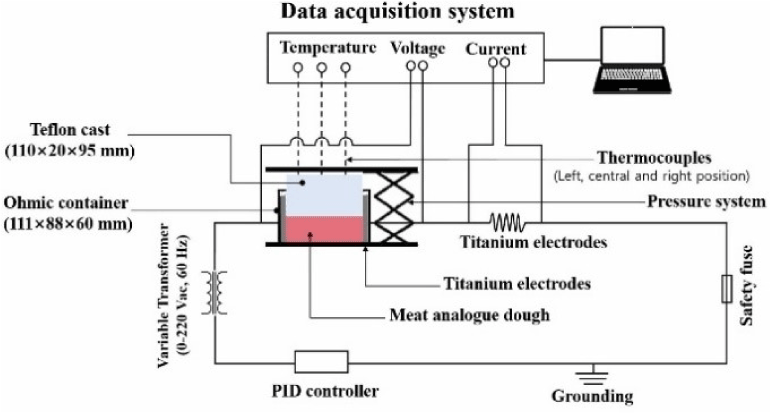 Customized ohmic cooking system |
Adapted from Jung et al. (2022) with CC-BY. |
| High-moisture extruded meat using PPI | • Pilot scale twin screw extruder: screw length/diameter ratio of 24:1 • Barrel temperature profiles were controlled at 25°C, 60°C, 90°C, 145°C, 145°C, and 120°C along the extrusion direction and the cooling die temperature was controlled at 70°C. The extruder was intentionally stopped after the motor torque and die temperature had reached a steady state. The cooling die was quickly disassembled and the screws removed in 5 min. Samples of the feed zone (raw material), mixing zone, melt zone, die, cooling zone, and extrudates were collected as quickly as possible. |
High-moisture extrusion using twin-screw extruder | Chen et al. (2022) |
| Vegan sausage using jackfruit; banana floret | •The immature jackfruit was soaked in water at 50°C for 10 min, and the banana florets were blanched for 5 min after removing the calyx, spine, and steam. • These were crushed, mixed, and added to a manual cold extrusion-based sausage stuffing gusset. • All three sausage formulations: S1: Raw jackfruit 60%, banana floret 0% S2: Raw jackfruit 0%, banana floret 60% S3: Raw jackfruit 30%, banana floret 30% • The other amounts were fixed at green peas isolate: 8%, and other ingredients: 32%. |
Commercial sausage-making procedure | Keerthana Priya et al. (2022) |
| Plant-analog nugget (PPN) using pea protein; wheat protein | • Each meat analog was 100 g and was used with cold water 57 g, potato starch 18 g, vegetable oil 3.5 g, CaCl2 0.2 g, salt 0.3 g, baking powder 2.5 g, and methylcellulose 1.5 g. • Formulation of PPN analogues: PP17: Pea protein 17%, wheat protein 0% PP13: Pea protein 13%, wheat protein 4% PP8.5: Pea protein 8.5%, wheat protein 8.5% PP4: Pea protein 4%, wheat protein 13% PP0: Pea protein 0%, wheat protein 17% • Firstly, protein and methylcellulose were mixed for 3 min. Then, the dough was molded and steamed for 14 min at 100°C. • After the protein analog dough was fried, each protein analog was immediately frozen at –20°C for 48 h. |
Emulsion molding | Yuliarti et al. (2021) |
| High-moisture meat analogs (HMMA) using pulse protein (pea isolate, pea protein, lentil protein, and fava bean protein) | • HMMA 53.28 g, chilled water 28.61 g, minced dried onion 0.90 g, egg white powder (non-whipping) 5.39 g, carrageenan 0.49 g, beef flavor 2.69 g, black pepper 0.20 g, natural flavor enhancer 0.45 g, lactic acid 0.45 g, citric acid 0.05 g, methylcellulose 1.24 g, and shortening at 6.26 g of the total 100 g. • Pulse protein recipes to produce HMMA (200 g): C1: Soybean concentration 138 g, soybean isolate 20 g T1: Pea isolate 126 g, pea protein 32 g T2: Pea isolate 126 g, lentil protein 32 g T3: Pea isolate 118 g, fava bean protein 40 g • The other amounts were fixed at wheat gluten: 30 g, and canola oil: 12 g • The barrel of the Wenger twin-screw extruder has 6 heads, and the recipe was supplied at a speed of 9 rpm. |
 High-moisture extrusion using twin-screw extruder 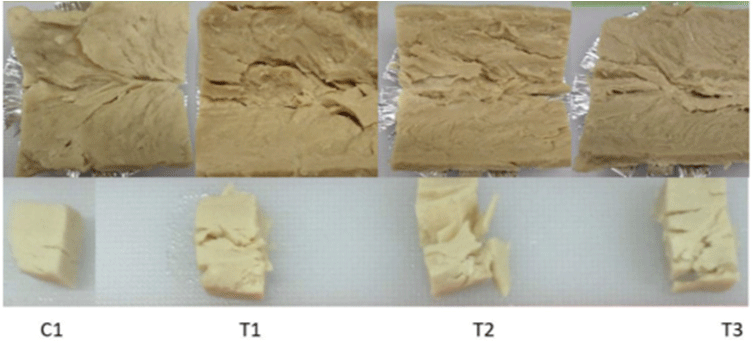 |
Adapted from Kim et al. (2021b) with CC-BY. |
| High-moisture extrusion using peanut protein powder | • Ingredients: Peanut protein powder, Carrageenan, sodium alginate, wheat starch • Pilot scale, co-rotating, and meshing biaxial food extruders were used. • The dry mixture was fed into the extruder at a constant rate of 6 kg/h. Feed moisture: 55% Screw velocities: 210 rpm Extruder barrel temperature: 60°C, 90°C, 155°C, 155°C, and 110°C (from zone 1 to zone 5, respectively). Cooling die temperature: 70°C |
High-moisture extrusion using twin-screw extruder | Zhang et al. (2020) |
| Extruded meat analogs using soy protein concentrate (SPC), wheat gluten (WG) | • The extrusion formulation (%) w/w of non-water ingredients: 1: SPC 89: WG 0 2: SPC 79: WG 10 3: SPC 69: WG 20 4: SPC 59: WG 30 • The other amounts were fixed at vegetable oil 5%, pumpkin powder 3%, wheat starch 2.7% and salt 0.3%. • FMA under 57% water content was extruded at a max barrel temperature, at a dry rate of 2.8 kg/h, and a water feed rate of 3.6 kg/h. |
High-moisture extrusion using twin-screw extruder | Chiang et al. (2019) |
| Structured soy-based meat analogs using SPI, WG | • Meat analog structure formation: follow the flow direction (inner rotating cylinder → stationary outer cylinder), rotation rate, temperature, and process time. First step: Temperature was changed from 90°C to 110°C at 5°C intervals, rotation speed was 30 rpm, and process time was 15 min. Second step: Rotation speed was changed from 0 to 50 rpm in 5 rpm intervals, process time was 15 min, and temperature was 95°C. Third step: Temperature was 95°C, rotation speed was 30 rpm, and process time was changed from 5 min to 25 min in 5 min intervals. |
Fibrous anisotropic and layered materials using a couette cell | Krintiras et al. (2015) |
Since plant-based proteins are the most commonly used food ingredient with meat, research on their use as meat analogs forms the majority of reviewed research studies. However, almost all studies have focused only on the protein-fiber structure and nutritional and textural characteristics of plant-based protein products. Currently, plant-based materials have been found to be the most used material for manufacturing meat analogs. As a result of investigating many research results, it was found that meat analogs manufactured with plant-derived substances do not yet provide the same taste and quality characteristics as traditional meat products. Indeed, soybean types represent the most commonly used material for manufacturing meat analogs since they are thought to be high in protein, easy to obtain, and inexpensive.
Summary of Current Technologies and Industrialization in Meat Analogs Made from Insect-Based Materials
The edible insect market has been highlighted as an important future food market due to the rapid increase in population growth and it being a very environmentally friendly resource (Kiiru et al., 2020; Megido et al., 2016). People around the world have consumed locusts, mealworms, and slugs as snacks or side dishes and they were fried, sautéed or cooked in dry form (Choi et al., 2022; Yu, 2022). These recipes, which preserve the form of raw materials as they are, can create disgust for some consumers, which can be a factor that hinders their demand (Castro and Chambers, 2019). Nevertheless, insects are excellent meat analogs with high protein content of about 53.45 g per 100 g (Chen et al., 2010). Therefore, most insect materials have been added in powder form and used for cooking (cookies, protein supplements, etc.), and in this process, removing the peculiar odor of insects is one of the important pre-treatments (Liceaga, 2021; Mishyna et al., 2020). A list of meat analog studies using these insect-based materials is shown in Table 2. Baik et al. (2022) added Gryllus bimaculatus powder to a soybean meat substitute and 3D printed it, resulting in improved product texture. G. bimaculatus is an excellent food material among edible insects allowed in Korea due to its superior protein content (Baik et al., 2022). Compared to the control group with isolated soy protein added, the hardness and elasticity of the final product improved as the G. bimaculatus powder was added, with the characteristics of the 6% replacement treatment group being the highest (Table 2). Among them, the treatment group that replaced 3% showed the most similar texture to soybean-based meat, which had been prepared using soybean protein isolate as the control. Similar to isolated soybean protein, the more G. bimaculatus powder added, the more the texture characteristic of the meat substitute decreased; therefore, it was confirmed that the use of a binder should be considered to compensate for this (Baik et al., 2022). Megido et al. (2016) summarized western insect-based alternative meat and the views of the consumers on it. Mealworm (Tenebrio molitor L.), an edible insect, was prepared in powder form after fasting and was prepared into patties with beef or green lentil powder (Table 1). Participants (consumers) preferred the beef patty (BB) among the four total patties [BB, lentil (LB), mealworm/beef (MBB), and mealworm/lentil (MLB)] based on the overall liking and appearance. The next preferable tastes were, in descending order, the BB, MBB, MLB, and LB (Megido et al., 2016). This indicates the possibility that mealworms can effectively complement the taste of vegetable protein analogs and mimic the taste of beef. Kiiru et al. (2020) cooked SPI mixed with cricket flour (CF) using high-moisture extrusion, similar to previous studies on plant-based meat analogs. The temperature and water flow rate were adjusted to achieve a characteristic similar to meat, while a high temperature or low water flow rate increased the tensile strength of the product (Table 1). The treatment with crickets could form a denser fiber structure than the treatment with soybean protein alone, and the tensile and tenderness could also be improved (Kiiru et al., 2020). When comparing all treatments, the most meat-like product was produced when the 30% low-fat CF dough which was extruded at a water flow rate of 10 mL/min at 160°C (Kiiru et al., 2020). Similarly, in a study using Alphitobius diaperinus and T. molitor, it was confirmed that the products prepared by mixing insect-derived protein concentrates with soy protein concentrates exhibited hardness similar to products made using soy protein (Smetana et al., 2018; Smetana et al., 2019). Initially, Smetana confirmed that mixing 40% A. diaperinus and 5%–10% soy fiber (soy dry matter) could produce meat analogs with a hardness, texture, and protein composition most similar to chicken breast (Smetana et al., 2018). Subsequent studies used both A. diaperinus and T. molitor, and when 15%–40% of both insect proteins were added, the texture of meat was effectively expressed (Smetana et al., 2019). In addition, the low hardness product was improved by increasing the barrel temperature of the extruder (170°C), confirming the basis for applying high-protein insect-derived materials (A. diaperinus, T. molitor) to meat analogs (Table 2; Smetana et al., 2019). In addition, by raising the barrel temperature of the extruder (170°C) to improve the low hardness product, meat analogs using high-protein insect-derived materials (A. diaperinus and T. molitor 40%) showed a texture similar to that of chicken breast or 100% soy protein concentrate (Smetana et al., 2019). Stoops et al. (2017) provided microbial information during the production and storage of ground meat products produced by adding two types of mealworm larvae (A. diaperinus and T. molitor). In addition, in order to realize the optimal taste and texture of the two mealworm larvae as a meat substitute material, other cooking methods such as steaming and frying were recommended (Table 2; Stoops et al., 2017). It was confirmed that minced meat products with mealworm larvae delayed the growth of microorganisms better than without, which suggests that meat analogues with these advantages could have prolonged shelf life (Stoops et al., 2017). Another study on patty manufacturing used only mealworm protein powder with bean curd (Kim et al., 2015). Here, the sensory evaluation result was the best when 20% mealworm powder was added to the total weight of the patty, which also resulted to a crude protein content of this patty was higher than in a general beef patty (Kim et al., 2015). In addition, it was confirmed that mealworm powder could produce nutritionally superior patties by containing sufficient amounts of protein and branched-chain amino acids (valine, leucine, and isoleucine; Kim et al., 2015).
| Main source of products | Ingredients or technologies | Main procedure and products | References |
|---|---|---|---|
| Meat analog with Gryllus bimaculatus and soy protein | • G. bimaculatus were washed by fasting for 3 days, dried with mid-infrared rays, and then pulverized with a blender. • Formula of a soy meat added with different levels of G. bimaculatus powders: CON: Cricket powder 0%, isolated soy protein 17% CP3: Cricket powder 3%, isolated soy protein 14% CP6: Cricket powder 6%, isolated soy protein 11% CP9: Cricket powder 9%, isolated soy protein 8% • The other amounts were fixed at patato starch 13%, CaCl2 1%, KCl 1%, methyl cellulose 0.5%, transglutaminase-B 0.6%, distilled water 66.9%. |
3D food printer | Baik et al.(2022) |
| Insect-based burger using mealworm (Tenebrio molitor L.) | • Mealworms were grown with flour, brewed yeast, and wheat bran. The insects fasted for 24 h before being frozen to ensure they were excreted. • Green lentils and mealworms were pre-cooked in 500 mL boiling water (99.5°C±0.5°C) for 30 and 10 min, respectively, and then, incorporated into the patty. Burger patties composition: BB: Unflavored grounded beef 95% MBB: Unflavored grounded beef 45%, mealworms 50% LB: Green lentils 95% MLB: Green lentils 45%, mealworms 50% • After precooking, the burger ingredients were mixed with a hand blender for 3 min to obtain a homogeneous mixture. • The molded patties were cooked in a preheated hot-air oven at 180°C±5°C for 15 min. |
Burger patties | Megido et al. (2016) |
| Fibrous meat analogs with soy protein isolate (SPI), full-fat cricket flour (FCF), low-fat cricket flour (LCF) | • Mixture feeding speed: 0.4 kg/h, screw speed: 150 rpm • The temperature for each zone was different: 1st–4th zone: 40°C, 60°C, 80°C, and 100°C 5th zone: 120°C, 140°C or 160°C Water flow rate: 9 mL/min or 10 mL/min Colling die temperature: 80°C • Blends formulation (ratio): 100% SPI: SPI 100 15% FCF/LFC: SPI 85, FCF/LCF 15 30% FCF/LFC: SPI 70, FCF/LCF 30 45% FCF/LFC: SPI 55, FCF/LCF 45 |
High-moisture extrusion using twin-screw extruder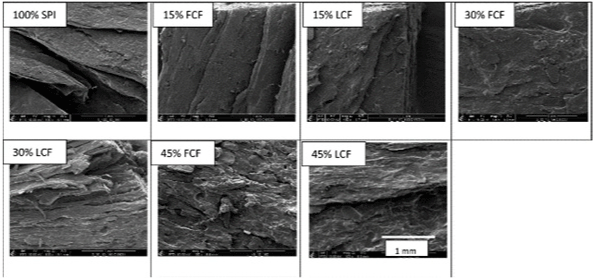 |
Adapted from Kiiru et al. (2020) with CC-BY. |
| High-moisture extruded intermediate using Alphitobius diaperinus T. molitor | • A. diaperinus protein concentrate (68% protein content on dry matter basis), T. molitor protein concentrate (66% protein content on dry matter basis), soy protein concentrates (69% protein contents) • Gradual addition of insect protein (A. diaperinus, T. molitor) to soy protein concentrate: 15%–70% • High-moisture extrusion was performed in DIL (Quakenbrueck, Germany) using a co-rotating twin-screw 51 extruder with 1,920 mm long screw barrel and a long die (dimensions: 20×2×210 mm). • Mixture feeding speed: 3.41 kg/h, screw speed: 400 rpm • Barrel temperature: 160°C (6.5–8 N) to 170°C (8–11 N) |
High-moisture extrusion using twin-screw extruder | Smetana et al. (2018) |
| Minced meat-like products using mealworm larvae; A. diaperinus (Lesser) and T. molitor (Yellow) | • Fresh yellow mealworms (YM) were steamed for 5 min and pulverized with a mixer. • Insect mixture was made using a spoon (40 g of YM powder, binding agent, salt, white pepper, onion powder, nutmeg, and paprika powder) and pan-fried with 4–5 mL of peanut oil for 2 min. • Fresh lesser mealworms (LM) were fried in a wok for 2 min and pulverized with a mixer. • Insect mixture was made using a spoon (40 g of LM powder, binding agent, salt, white pepper, onion powder, and nutmeg) and pan-fried with 4–5 mL of sunflower oil for 2 min. |
Pan frying minced meat-like products | Stoops et al. (2017) |
| Patty prepared with mealworm powder | • Mealworm pretreatment: fast for 2 days, wash, snap-freeze in liquid nitrogen, and deep freeze for 24 h (–70°C), then, freeze-dry for 48–60 h, and pulverize until powdered. • Formula of patties prepared with mealworm powder: M0: Mealworm 0%, bean-curd 40% M10: Mealworm 10%, bean-curd 30% M20: Mealworm 20%, bean-curd 20% M30: Mealworm 30%, bean-curd 10% M40: Mealworm 40%, bean-curd 0% • The other amounts were fixed at gluten, water and sub-ingredients 20% |
Pan frying patties | Kim et al. (2015) |
In the case of meat substitute manufacturing studies using edible insects, the focus was on reducing the negative perception of the nutritional, taste, or material of edible insects rather than imitating the structure of meat itself. Therefore, a large amount of manufacturing technology was applied in the case of mixing simple powdery materials with meat or vegetable analogs (such as soybean protein). Compared to plant-based materials, these studies mostly analyzed the preparation of meat mixtures rather than the meat itself. However, a number of studies were conducted on the pretreatment methods necessary to supplement the taste and texture to create a sense of incongruity with edible insects, and to confirm the possibility of their use as a meat substitute material. Research on developing meat analogs using insect-derived materials has used solely insects and has also mixed them with vegetable proteins (soybean-derived) in an attempt to make them similar to traditional meat products.
Summary of Current Technologies and Industrialization in Meat Analogs Made from Mycoprotein Materials
The last predominantly used meat analog material is mycoprotein, the process of which is shown in Table 3. In studies using mycoprotein, the main focus is on the safety of ingestion. While mycoprotein as an entity may be unfamiliar to the general population, the most familiar and similar material to consumers is mushroom mycelium. Bartholomai et al. (2022) suggested the possibility of manufacturing animal-free meat substitutes using Neurospora crassa mycoprotein, and these mycoproteins are prepared through rinsing and dehydration. Analysis of the possibility of toxicity and allergies relating to the protein of N. crassa for its use of the mycelium as a food product revealed no great risks. Moreover, N. crassa mycoprotein is a protei-rich source which also contains various fibers, potassium, and iron (Bartholomai et al., 2022). The protein obtained from Fusarium strain flavolapis contains all nine essential amino acids and has protein, fiber, vitamins, and minerals in semi-solid forms (Furey et al., 2022). It also has no mutagenic or genotoxic potential, so it is predicted to be sufficient to replace animal proteins (Furey et al., 2022). Sausages with added mycoprotein remains of good quality and microbial growth was not observed (Shahbazpour et al., 2021). Moreover, sausages with mycoprotein added have higher protein, lower fat, and lower carbohydrates than beef sausages, and have excellent water and oil binding ability, meaning less oil and water can be used during manufacturing (Shahbazpour et al., 2021). In addition, the content of essential amino acids and unsaturated fatty acids was higher than in beef, and the sausages were nutritionally superior (Shahbazpour et al., 2021). A review published by Ahmad et al. (2022) addressed the production, nutrition, and benefits of mycoproteins. Fusarium venenatum is the most famous mold used in the food industry processed with egg albumin and other additives (Ahmad et al., 2022). Furthermore, a mycoprotein extraction method using agro-industrial waste was presented. Extraction methods included submerged, the solid-state fermentation, and surface culture (Table 3). A method for producing mycoproteins by inoculating Paradendryphiella salina, Agrocybe aegerita, Aspergillus niger, and Rhizopus oryzae to wastes such as date palm, sugarcane, fruit, discarded bread, and brewer-spent grain was studied (Ahmad et al., 2022). Manufactured mycoprotein products have already been demonstrated to provide a rich supply of essential amino acids, proteins, and minerals, while the intake of these mycoproteins has been shown to affect blood insulin, glucose levels, lipid profiles, and muscle protein synthesis in subjects of different body types (Ahmad et al., 2022). In addition, the manufactured mycoprotein product has a texture similar to that of meat, resulting to high consumer preference (Ahmad et al., 2022). Interestingly, Gamarra-Castillo et al. (2022) made a hamburger patty using fungal protein (Aspergillus oryzae). They set up an optimal medium by adjusting carbon sources and its proportion with nitrogen to mass-produce A. oryzae (Gamarra-Castillo et al., 2022). After fermentation of the mycelia and undergoing a series of reactions to remove RNA, they were heated and a precipitate was obtained. Additives such as flour, binder, and colorant were used to improve quality when manufacturing patties with mycoprotein (Table 3). The most suitable medium additive for mycoprotein production was maltodextrin, which produced the highest biomass (Gamarra-Castillo et al., 2022). In addition, through analysis using an electronic tongue and texture analyzer, it was confirmed that the addition of quinoa flour, carboxymethyl cellulose, and beet extract produced products most similar to real meat (Gamarra-Castillo et al., 2022). In the study of Rousta et al. (2021), A. oryzae was mass-produced in a bioreactor system using oats to produce mycoproteins. They established optimal biomass production conditions by applying various concentrations of oat flour and temperature (Table 3). After the cultivation period, the biomass (mycoprotein) protein content increased from 11% to 37%, which were then dehydrated to make patties (Table 3; Rousta et al., 2021). In the evaluation of burger intake, consumers showed a tendency to either not particularly like the vegetarian fungi burger or to further dislike it (Table 3; Rousta et al., 2021).
| Main source of products | Ingredients or technologies | Main procedure and products | References |
|---|---|---|---|
| Neurospora crassa mycoprotein | • The liquid culture was expanded by supplying agitation and aeration in a controlled bioreactor, while maintaining sterile conditions (dry, shelf-stable ingredient). • The mycelium was harvested, rinsed, and dewatered, to form mycelial ingots uniform in size. • Subsequently, the ingots were shredded, dehydrated, and devitalized to neutralize the organism and prevent microbial contamination. |
Shred, dehydration and devitalization | Bartholomai et al. (2022) |
| Fusarium strain flavolapis protein | • Construct fermentation media from raw materials used in the food, fermentation and enzyme production industries (food grade, high quality chemical or pharmaceutical grade). • After the semi-solid fungal biomat is formed, it is harvested and subjected to high temperature and dehydration. |
Deactivation and dehydration | Furey et al. (2022) |
| Mycoprotein sausage | • Sausage ingredient: meat/mycoprotein 40%, sunflower oil 10%, ice 20%, mixed spices 3.5%, soy protein isolate 5%, gluten 10%, flour 10% and salts 1.5%. • Sausage ingredients are mixed slowly except spices and oil. In mixing process, ice was added continuously. Then, spices and oil added to mixture, total mixing time is 10 min. The batters maintain temperature below the 12°C, and they were stuffed to cellulose casing. The sausages were cooked at 76°C in 60 min. |
Sausage-making procedure | Shahbazpour et al. (2021) |
| Mycoprotein from agro-industrial waste | • There are three methods for producing mycoprotein, submerged fermentation, solid-state fermentation, and surface culturing. • These three ways have common steps, which are culture preparation and inoculum preparation, which occur at 25°C–28°C. 1) Submerged fermentation (SmF) - The cells were subcultured in medium, which is composed of carbon, 1.5% salinity, and 4 g/L yeast nitrogen base. - The submerged culture was moved to a SmF bioreactor to scale up the seed culture 2) Solid-state fermentation (SSF) - After the common step, mycelium is cultivated in a medium containing 40% moisture and 95% RH. 3) Surface culturing - Inoculum spreading on medium, which uses 20 g/L glucose and 4 g/L potato extract. - The cells, which underwent inoculum spreading, were cultured with surface of a static way. |
Quorn-mycoprotein production process | Ahmad et al. (2022) |
| Burger patties using Aspergillus oryzae protein | • Ingredents of A. oryzae medium based on malt extract medium Carbon source: Maltodextrin or glucose Carbon to nitrogen ratio: 15:1, 20:1 or 30:1 • Product factor design 1) Flour: Quinoa flour and rice flour 2) Binder: Carboxymethyl cellulose and the enzyme transglutaminase 3) Color: Beet extract and annatto • General formulation composition: Mycoprotein 55%, flour 20%, binder 3%, color 5% and other ingredients 17% ACA: Formulation composed by rice flour, CMC, and annatto ACR: Formulation composed by rice flour, CMC, and beet extract ATA: Formulation composed by rice flour, TG, and annatto ATR: Formulation composed by rice flour, TG, and beet extract QCA: Formulation composed by quinoa flour, CMC, and annatto QCR: Formulation composed by quinoa flour, CMC, and beet extract QTA: Formulation composed by quinoa flour, TG, and annatto QTR: Formulation composed by quinoa flour, TG, and beet extract |
Dehydration and RNA reduction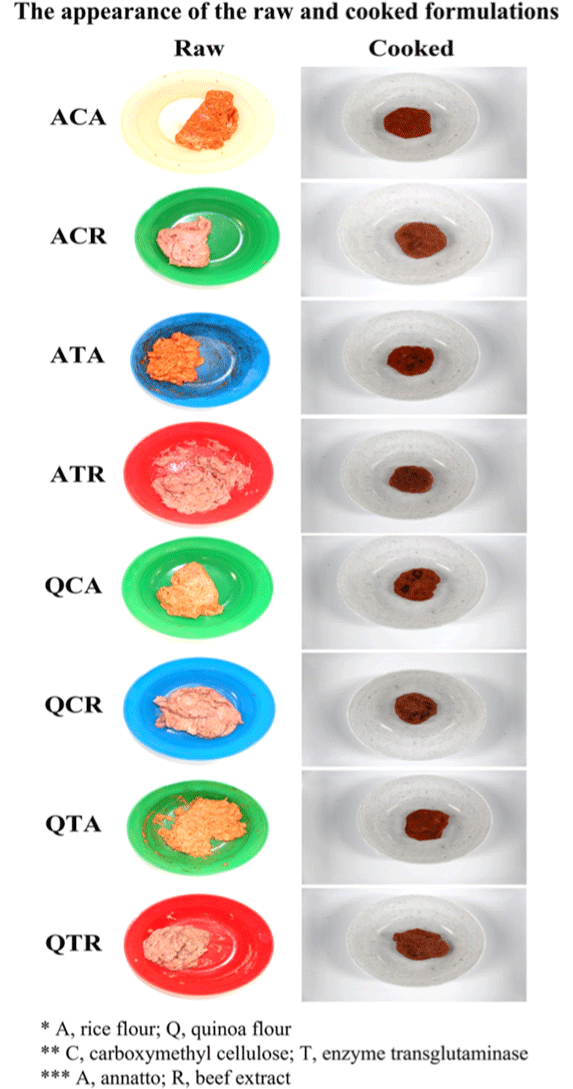 |
Adapted from Gamarra-Castillo et al. (2022) with CC-BY. |
| Fungal patty using biomass (A. oryzae) | • Producing fungal biomass steps: 1) The fungal spores were propagated from culture 2) The spores were used to prepare a preculture in 1 L shake flasks 3) The biomass from the 26 L reactor was used as seeding for the pilot 1,200 L airlift reactor • The specific concentration (30, 40, 50 and 60 g/L) of oat flour for cell was mixed in 100 mL with varying water temperatures, including in 22°C, 50°C, 60°C, 70°C, 80°C, and 90°C. • The media for 26 L bioreactor contained 20 g/L oat flour, 10 g/L sucrose, and 100 mL oil. • Vegan patties use starch as a binder, and vegetarian patties use egg white as a binder. |
Vibration screen, dehydration and freeze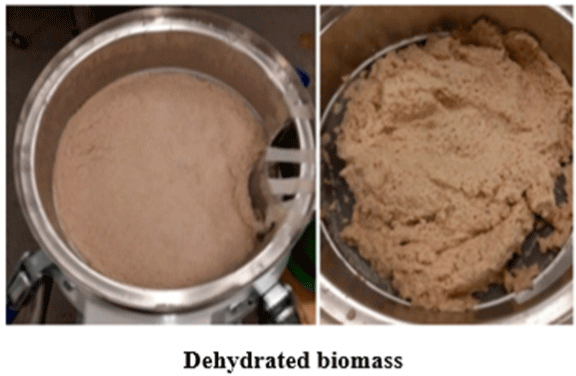 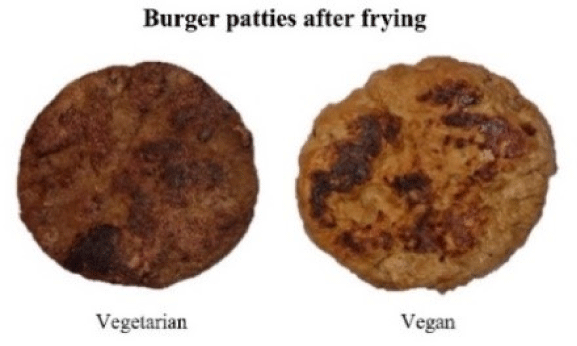 |
Adapted from Rousta et al. (2021) with CC-BY. |
These negative results indicate that it is necessary to consider consumer-preferred taste and texture in using alternative proteins for food.
Mycoprotein technology, unlike the other two technologies (plant and insect), focuses on the technology of processing the raw material itself. In particular, due to the nature of using mycelium, a lot of research has been conducted on conditions that can maximize mycelium production (Gamarra-Castillo et al., 2022) or basic technology to remove the effects of toxins, such as aflatoxin and fumonisin, which can be produced by mycelium (Bartholomai et al., 2022; Furey et al., 2022). Mycoprotein has a mycelial structure that is advantageous in mimicking the structure of meat, while its nutritional value is similar to or better than meat. Further, in some studies, it has presented physiological activity through ingestion, thereby demonstrating its value as a future meat substitute (Gamarra-Castillo et al., 2022). However, upon investigation, there are only a few studies that have evaluated the manufacturing of meat analogs using mycoprotein compared to other materials because it is relatively difficult to obtain compared to the more conventional plant-derived or insect-derived materials, while the related information on it is also limited. In addition, since mycoprotein is a material derived from fungi, there are also research issues related to safety. Therefore, in order to develop meat analogs using mycoprotein, additional research is required on both its safety and the fermentation method to obtain mycoprotein or the characteristics of the mycoprotein.
Future Perspective and Conclusion
Recently societal and scientific views have switched to believing that meat analogs made from plant-based, insect-based, or mycoprotein sources typically have a lower environmental impact compared to traditional meat production methods. Therefore, they are suggesting that choosing meat analogs made from alternative sources improves animal welfare by reducing the demand for animal-based products.
In terms of human health, plant-based, insect-based, and mycoprotein meat analogs often contain less saturated fat and cholesterol compared to traditional meat, which can be beneficial for cardiovascular health. They can also fulfill great dietary requirements relating to fiber, vitamins, and minerals that are beneficial for overall health. Moreover, meat analogs made from alternative sources provide options for individuals with specific dietary restrictions or allergies. The development of meat analogs made from alternative sources fosters culinary innovation and expands the range of available food options. However, there remains a lot of negativities surrounding meat analogs. Especially, regarding some meat analogs potentially containing additives, preservatives, or excessive sodium, which can negatively affect those seeking minimally processed or whole foods. Even though the taste and texture of meat analogs have continued to improve over time, some individuals still find them less satisfying or different from consuming meat; however, this can vary based on personal preferences and expectations. In terms of nutrition, they might lack certain vitamins (such as vitamin B12) or minerals that are in animal products; therefore, extra attention should be placed on maintaining a balanced diet. Additionally, meat analogs made from alternative sources can also potentially trigger allergies or sensitivities in some individuals–for example, insect-based meat analogs may not be suitable for individuals with insect allergies. Meat analogs made from alternative sources may face regulatory challenges or labeling issues, which can impact consumer confidence and clarity regarding their composition and nutritional information. Therefore, when evaluating meat analogs made from alternative sources, such as plant-based, insect, or mycoprotein, it is important to consider both the positive and negative factors associated. Although the market for meat analogs is likely to continue to grow, a number of important issues must be addressed: Firstly, the biggest obstacle to the growth of meat analogs is the lower preference for them by the consumer compared to traditional meat products. Therefore, to replace the consumption of traditional meat products, the texture or flavor of the alternatives must be very similar, yet the current meat analog products that are sold in the markets are not as highly rated by customers. Therefore, more research is needed that evaluates the health benefits as well as the texture and flavor. In addition, the conflict between meat analogs and the livestock industry remains an issue that national governments in each country need to solve. The argument between the meat analog industry and the livestock industry can be addressed through open communication, collaboration, and a focus on shared goals. Furthermore, the benefits and drawbacks of both meat analogs and livestock products should be promoted with full transparency to educate the global population. This would include, providing accurate information about the production procedures, nutritional profiles, and environmental impacts, which would help consumers to make informed choices. One more solution is the development of clear and fair policies and regulations that apply to both the meat analog and livestock industries. Unique characteristics and challenges are faced by each sector and need to be considered to ensure a level playing field, which supports innovation, consumer safety, and environmental sustainability. We recognize that both the meat analog industry and the livestock industry can contribute to addressing the overall global challenges, such as food security and climate change. Thus, collaboration on research and initiatives is highly encouraged to find sustainable solutions that benefit both industries and society as a whole.













